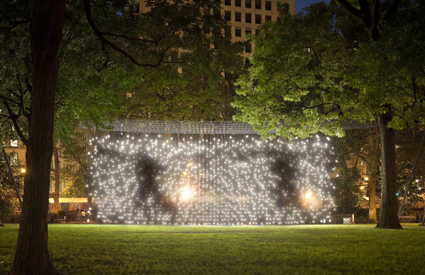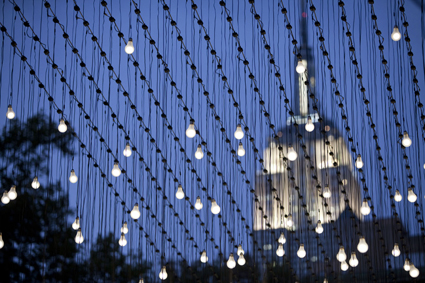jim campbell: low resolution light magician
keith gallasch: media artist jim campbell, perth international arts festival

Scattered Light, Jim Campbell
photo James Ewing
Scattered Light, Jim Campbell
SAN FRANCISCO-BASED PIONEERING MEDIA ARTIST JIM CAMPBELL, RENOWNED FOR HIS CUSTOMISED ELECTRONICS AND UNIQUE LIGHT SCULPTURES, IS FEATURED IN THE 2012 PERTH INTERNATIONAL ARTS FESTIVAL WITH HIS MUCH LAUDED INSTALLATION, SCATTERED LIGHT. PHOTOGRAPHS AND VIDEO REVEAL VERY LITTLE ABOUT THE ACTUAL EXPERIENCE OF APPROACHING A STARRY WALL OF LIGHTS IN A PUBLIC PARK AT NIGHT AND, DRAWING CLOSE, DISCOVERING SOME 1,800 TRADITIONAL LIGHT BULBS SUSPENDED AT VARIOUS HEIGHTS IN THREE-DIMENSIONAL SPACE.
As well, at a distance you might notice human shadows hurrying across the light field, as if on a screen, but up close these movements are abstract—the nature of the artwork has changed, and your experience of it. Doubtless, as your senses adjust, questions spring to mind. Whose shadows? Why light bulbs? Why the perceptual shift?
Campbell, with degrees from MIT in Electrical Engineering and Mathematics, has since the late 1980s combined technological know-how with art to create interactive and other works exhibited around the world in galleries and public spaces. His latest creation, Exploded Views (2011), suspended in the San Francisco Museum of Modern Art’s atrium (until October 23 this year), uses 3,000 LED lights that comprise a “gigantic three-dimensional ‘monitor’” on which are ‘screened’ four films (each shown over a two-month period) of contemporary dancers, a flock of birds, pedestrians and boxers.
Scattered Light is not as complex as Exploded Views but works from similar principles in the creation of the shadowy figures generated by the flickering lights.
Campbell, an experienced filmmaker, videos pedestrians, maximises the contrast to eliminate intrusive detail and downloads the images to his customised (and patented) computer circuitry which controls the on/off position of each light bulb, thus impressionistically reproducing human movement. The mass of lights effectively becomes a three-dimensional LED screen.
I asked Campbell how he came to focus on perception. He explained that “it happened almost by accident years ago with a grant that [allowed me] to look at exploring low resolution imagery as an experiment. I was pleasantly surprised that there were a lot of interesting things about low resolution that I hadn’t seen or thought about before. And so it’s taken over my art thinking over the last 12-13 years.”
What did he learn about low-resolution imagery? “How rich something can be when you take most of it away. I became interested in what was left when you take away all the details and the colour we’re used to for defining an image. You take them away and there’s a lot left. Even more profoundly, what’s left is masked by all the other information that’s there. With a moving image of a person walking, your brain is trying to figure things out, looking at the colour, the edges, analysing that information. When you eliminate the details, all the sharpness, the high resolution, your brain doesn’t really analyse any more, it just takes it in, in what I would call a more primal way, and that makes sense because what is left is rhythm movement. With peripheral vision, which I’m also interested in, you’re only paying attention to movement. There’s an evolutionary reason for that—survival. I like creating images that are experienced more primally.”
I asked Campbell how this notion connected with the actual making of a work like Scattered Light. “I start with a video that’s very simple. If the background’s too complicated you can’t tell what you’re looking at—too much ‘noise.’ So I look for simple backgrounds and very big contrasts. In Scattered Light most people are wearing black but there are people walking past in white shirts; they’re not all shadow figures. In Grand Central Station most people were wearing black or dark colours. The background is the floor—I shot from above at an angle—so you’ll see white shirts against it.”
Why focus on walking? “It goes back to the primal. It’s such simple movement so we automatically understand it—we have an intuitive relationship with it— and it works best in low resolution.”

Scattered Light, Jim Campbell
photo James Ewing
Scattered Light, Jim Campbell
What’s the difference between Exploded Views and Scattered Light? “Conceptually they’re the same but Exploded Views has more resolution—nearly 3,000 pixels and twice the resolution and in a more controlled environment where there wasn’t wind. I didn’t necessarily know what I was going to do with Exploded Views—it was a kind of experiment. For 12 years I’ve been looking for a certain kind of imagery that would work with my technology. So I was very excited by designing the image and working with a choreographer. We created an image in a studio rather than me wandering around with a tripod for a week. The boxing we did in a gym with control of the background, shot it with five or six different cameras, but ultimately only using the one that worked by far the best.”
A striking characteristic of Scattered Light up close is its multitudinous light globes. Sometimes described as an homage to the traditional globe, the work is also a critique. The pleasing shape is contradicted by the device’s enormous power usage. Campbell was looking for low resolution and low wattage: “My assistants took an electric hacksaw to 2,000 light globes. They removed the tungsten filaments and replaced them with LEDs.” So the whole work then is a 3D LED display? “Right.” And a comment on this period of transition in our use of electricity? “Right.”
As an aside, Campbell, the engineer, reveals his disappointment with the new generation of domestic lights: “Ironically, LEDs have a very different quality than tungsten filaments and it has to do with the way heat is given off from the LEDs—it’s conducted rather than radiated, so [new generation] light bulbs should be designed completely differently from the old model. But because of the existing fixtures of the last 100 years the new lights now imitate the old bulbs. For Scattered Light we created a hybrid.”
Campbell’s work in the late 80s and 90s was notable for its digital interactivity. I wondered if it still played a role in his work. He said that it had been very important in the first 10 years of his practice but then he had become more interested in perception. However, the notion of interactivity remains embedded in his work of the last decade: “Scattered Light is extremely interactive because it will look abstract from 90% of the places you view it from and it will only resolve in certain areas. So you’re constantly moving to and away to change your perception of it—moreso than for a typical image or painting. It’s a different kind of interactivity.”
tenebrae et lux
Campbell’s technical prowess will be demonstrated in another Perth Festival work, an installation-cum-concert, Tenebrae et Lux (Darkness and Light) by pioneering French interactive video artist Benjamin Bergery who will responsively light the University of Perth’s Winthrop Hall for a performance of Carlo Gesualdo’s intrinsically dramatic, 400-year-old Tenebrae Responoria as performed by the St George’s Cathedral Consort singing acapella. The Bergery work is a Perth Festival commission.
Originally, as they had in Paris and the US, Campbell and Bergery were to collaborate on Tenebrae et Lux, but Campbell’s workload prevents it on this occasion. Bergery will instead work with a Campbell system using lighting controllers software that can modulate the lighting according to certain rhythms.
What’s keeping Campbell at a distance from Tenebrae et Lux is a major commission from San Diego Airport due for completion in 2013 as part of their Green Build: Public Art program. Campbell describes it as a 600 foot long, six feet wide sculpture—an undulating ribbon of light suspended over the walker and with an image that stays with you as you travel the concourse. He admits having to face some considerable challenges because of the scale of the work: “It’s made like Scattered Light and Exploded Views, but there are 35,000 pixels, each individually hung. It’s out of my realm how to do it. There’ll be a lot of subcontracting.” But the end result should be magical, maybe relaxing or strangely distracting.
other perth festival highlights
Chinese artist and activist Ai Weiwei is the designer for The Truth 25 Times a Second for Belgian choreographer Frédéric Flamand and the very contemporary Ballet National de Marseille. In 3G (Trois Générations) Idiosyncratic French choreographer Jean-Claude Gallotta collaborates with STRUT Dance and three generations of Perth performers—“innocent,” “professional,” “mature”—each responding to the same musical score as three discrete works. Robert Wilson’s production of Brecht’s The Threepenny Opera (1928) for the Berliner Ensemble is a must-see, with Wilson directing, designing and lighting. New York’s The TEAM in Mission Drift tackles 400 years of American capitalism using the tools of the musical. Great Australian pianist Sally Whitewell has her own recital but also joins Philip Glass and Maki Namekawa to perform all the Glass Etudes. Fans of contemporary music theatre will want to see Heinz Carl Gruber’s Frankenstein and Thomas Ades’ Living Toys in an outdoor concert titled Soft soft Loud: the Antihero Suite. For younger audiences Barking Gecko will stage, with a live orchestra, an adaptation of Wolf Erlbruch’s Duck, Death and the Tulip in which a duck and Death become friends. Melbourne’s Arena Theatre, in a co-commission with the festival, has invented The House of Dreaming, a hands-on house with robotics and projections and characters, directed by the ever inventive Chris Kohn. There are also six screenings of the award-winning Caesar Must Die by octogenarian filmmakers Paolo and Vittorio Taviani in a strong film program.
Perth International Arts Festival, Feb 8-March 2; www.perthfestival.com.au
RealTime issue #112 Dec-Jan 2012 pg. 6






